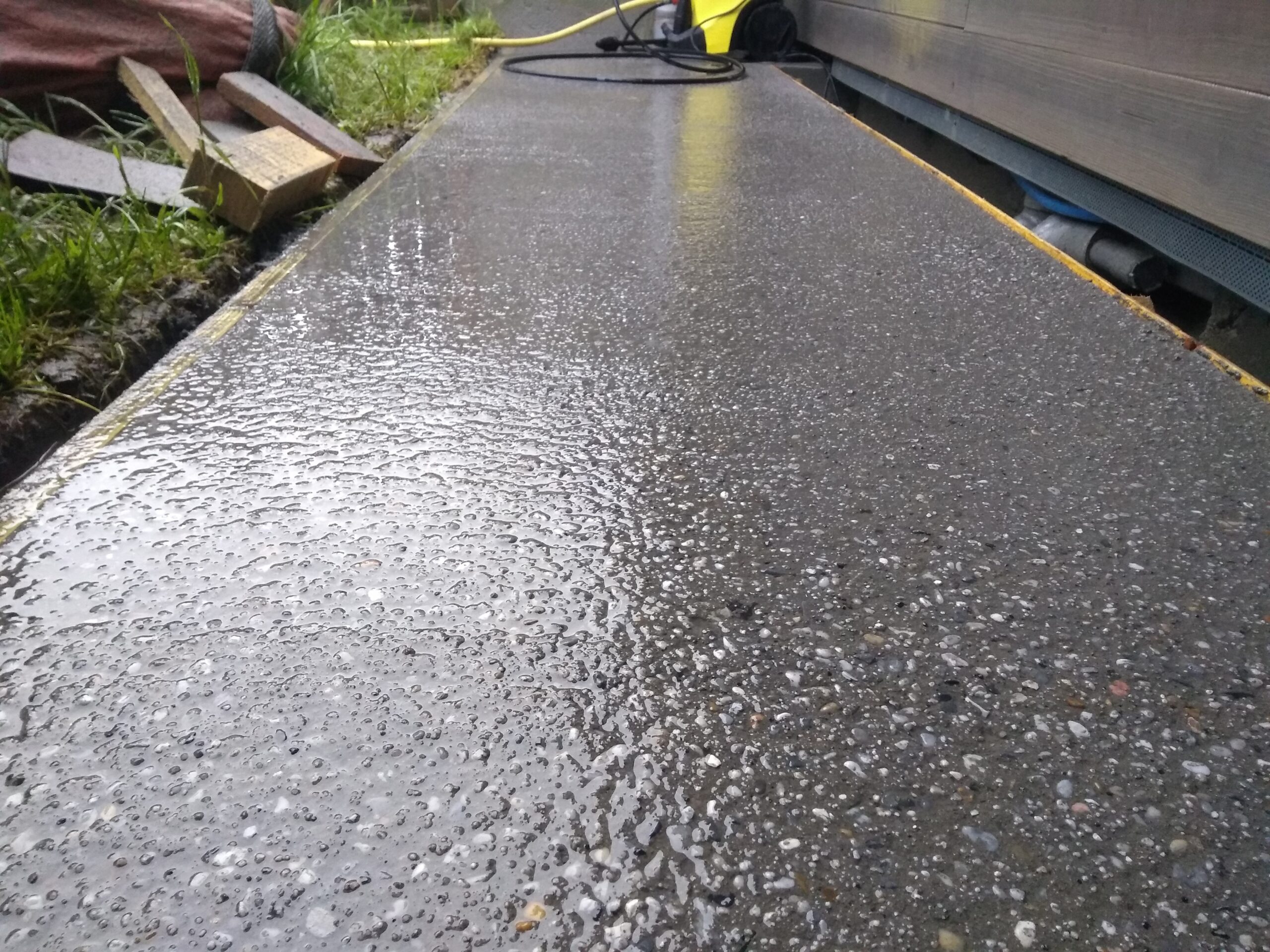If you’ve ever had new concrete poured, you know that the curing process is crucial. So, you may be wondering Can you pressure wash new concrete or not ! Well, the concrete needs to be kept moist so that it can harden properly. That’s why you often see contractors spraying water on new concrete or covering it with plastic.
But what happens if it rains before the concrete is fully cured? Can you pressure wash new concrete?
- Begin by rinsing the concrete with plain water to remove any loose dirt or debris
- Next, mix up a solution of pressure washing detergent and water according to the manufacturer’s directions
- Apply the detergent solution to the concrete with a low-pressure sprayer, working in small sections at a time
- Allow the detergent to dwell on the surface for 5-10 minutes before rinsing it away with clean water from a high-pressure washer
- Be sure to hold the nozzle of the pressure washer at least 12 inches away from the surface to avoid damaging the concrete
How Soon Can You Acid Wash New Concrete
After concrete is poured and finishes curing, you have to wait at least 28 days before acid washing new concrete. The ideal time to do an acid wash on new concrete is actually after it’s had a chance to weather for a few months. This gives the surface time to harden so that the etching action of the acid doesn’t penetrate too deeply.
Cleaning New Concrete
Cleaning new concrete can be a tricky task. If you use the wrong cleaner or method, you could end up damaging the surface. But with the right approach, you can get your new concrete looking clean and fresh in no time.
Here are a few tips to help you out:
1. Start by sweeping the surface to remove any loose dirt or debris.
2. Then, mix up a solution of mild dish soap and water.
Use a sponge or soft brush to scrub the surface with this solution.
3. Rinse away the soap with clean water and allow the concrete to air dry.
4. If there are any stubborn stains remaining, you can try treating them with distilled white vinegar.
Just apply it directly to the stain and scrub until it disappears.
How to Fix Damaged Concrete from Pressure Washer
If you’re using a pressure washer to clean your concrete, be careful not to damage it in the process. Here are some tips on how to avoid damaging your concrete and how to fix it if you do:
1. Use the right nozzle: A nozzle with a wide spray pattern is best for cleaning concrete.
Avoid nozzles with a narrow spray pattern, as they can concentrated the water pressure and damage the surface of the concrete.
2. Hold the wand at the right angle: Hold the wand at a 45-degree angle when cleaning concrete. This will help avoid damaging the surface of the concrete by keeping the water pressure from being too concentrated in one area.
3. Move slowly: Don’t move the pressure washer wand too quickly over the surface of the concrete or you’ll risk damaging it. Go slow and steady for best results.
4. Start with a low setting: If you’re not sure what setting to use, start with a lower one and work your way up until you find one that’s effective without being too harsh on your concrete.
Pressure Washer Damage Concrete
If you’re looking to add some extra Curb Appeal to your home, one of the best ways to do it is by Pressure Washing your Concrete. Not only will it make your home look cleaner, but it can also help to remove any dirt or grime that may be causing your Concrete to look dull.
However, before you start Pressure Washing your Concrete, there are a few things you need to keep in mind in order to avoid damaging it.
First of all, always use a low pressure setting when washing concrete – using too much pressure can actually chip away at the surface of the concrete and cause permanent damage.
Secondly, be sure to hold the nozzle of the pressure washer at least 12 inches away from the surface of the concrete while you’re washing it. This will help prevent any water from being forced under the surface of the concrete and causing cracking or other damage.
And finally, always let your Concrete dry completely before walking on it or adding any type of sealant or paint – otherwise you run the risk of trapping moisture underneath which could lead to mold growth or other problems down the road.
How to Pressure Wash Concrete
If your concrete is looking a little worse for wear, pressure washing it is a great way to give it new life. Here’s how to do it:
1. Make sure you have the right equipment. You’ll need a pressure washer with at least 3,000 PSI of pressure and a concrete-specific cleaning attachment. You can rent these from most home improvement stores.
2. Prep your area by covering any nearby plants or furniture that you don’t want to get wet.
Then, wet down the concrete with a garden hose to help reduce the risk of damage from the high-pressure water.
3. Start washing! Hold the nozzle about 10 inches from the surface of the concrete and move it back and forth as you work your way across the entire area. Be sure to overlap each stroke so you don’t miss any spots.
4. Rinse off the soap suds with clean water from your hose and let the concrete dry completely before walking on it or allowing anyone or anything else to come in contact with it.

Credit: www.youtube.com
How Long Do You Have to Wait to Power Wash New Concrete?
If you are planning to power wash your new concrete, you should wait at least 28 days before doing so. This will give the concrete time to cure and harden properly. Power washing too soon can damage the surface of the concrete.
How Do I Cure My Concrete before Pressure Washing?
If you’re pressure washing your concrete to prepare it for a new coat of paint or sealer, you’ll want to make sure the surface is clean and free of any contaminants. One way to do this is to cure the concrete before pressure washing it. Curing concrete helps to harden and strengthen the material, making it more resistant to damage from water and chemicals.
There are a few different ways you can cure concrete before pressure washing it. One method is to cover the surface with plastic sheeting or burlap sacks. This will create a humid environment that will help cure the concrete.
Another method is to sprinkler water over the surface regularly for about three days. This will also help create a humid environment that will speed up the curing process.
Once your concrete is cured, you can then pressure wash it using a power washer or garden hose with a nozzle attachment.
Be sure to start at the top of the surface and work your way down so that any debris or dirt is washed away evenly. Rinse off all soap residue with clean water once you’re finished pressure washing.
Should You Pressure Wash After Concrete?
If your concrete is new, you should wait at least 28 days after it’s been poured before pressure washing. This will give the concrete time to properly cure and harden. If you pressure wash too soon, you could damage the concrete.
Older concrete can be pressure washed as long as it’s in good condition. You should inspect your concrete before pressure washing to look for any cracks or other damage. If there is any damage, you’ll need to repair it first; otherwise, the pressure from the washer could cause further damage.
Generally speaking, you won’t need to use a lot of pressure when washing concrete. A lower setting will be just as effective and will be less likely to cause damage. Hold the tip of the wand about 6-8 inches from the surface of the concrete while you’re cleaning.
Can You Pressure Wash Sealed Concrete?
Yes, you can pressure wash sealed concrete. However, you need to take care not to damage the sealant. Use a low-pressure setting and hold the nozzle at least 12 inches from the surface.
Move the wand in a sweeping motion across the surface.
How to surface clean new concrete
Conclusion
If you’re wondering if pressure washing new concrete is a good idea, the answer is yes! Pressure washing will remove any dirt or debris that may be on your new concrete, and it will also help to keep it looking its best. Just be sure to use a mild detergent and don’t use too much pressure, as this could damage the concrete.

